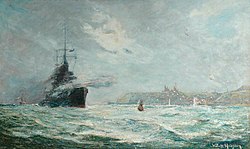Whitby
Whitby is a fishing port near Scarborough, North Yorkshire, in northeast England. 13,213 people live there. Its name comes from the Old Norse Witebi, which means the "white settlement".
Whitby is on the edge of the North Yorkshire Moors.
Its heritage coast is around 35 miles (56 km) long, stretching from Staithes to Flamborough. At Whitby, dinosaur footprints are visible on the beach. The black mineral jet is found in the cliffs and on the moors and has been used since the Bronze Age to make beads. In Victorian times jet was brought to Whitby by pack pony to be made into decorative items. It was most popular in the mid-19th century when it was chosen for mourning jewellery by Queen Victoria after the death of Prince Albert.
In the Middle Ages, Whitby was home to whaling and herring fishing fleets. Now, lobsters, brown and velvet crabs are important to the local fishery. Tourists first began to visit Whitby in the 1800s. Tourism is now the main source of income for Whitby.
Whitby's East cliff is the home of Whitby Abbey. On the West Cliff, a whalebone arch commemorates Whitby's fishing heritage.
Captain James Cook, a British explorer who mapped New Zealand, Hawaii and Newfoundland, learnt to sail in Whitby.
Part of Bram Stoker's story of Dracula is set in Whitby.
Whitby Media
The ruins of Whitby Abbey are reflected in the abbey pond
Whitby jet mourning jewellery became popular in late Victorian England
Henry B. Wimbush, Whitby Old Town, 1903
Old Town Hall, a grade II* listed building no longer in municipal use











